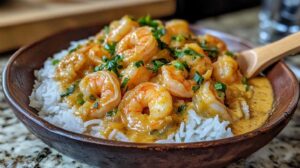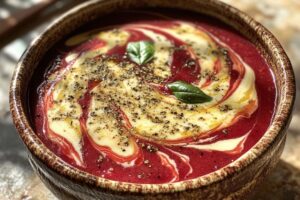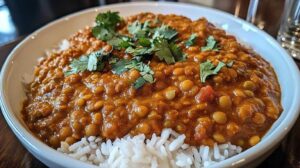This coconut chicken curry brings together the perfect balance of creamy coconut milk and fragrant spices in one comforting bowl. I still remember the first time I tried making this dish – the kitchen filled with such incredible aromas that my neighbors started asking what I was cooking.
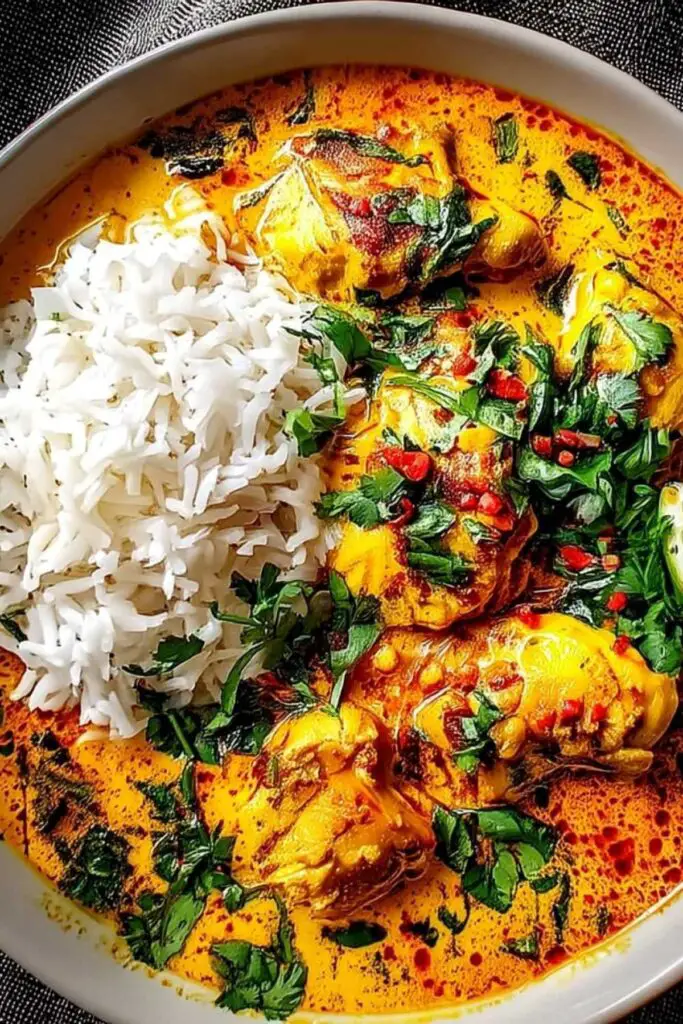
Growing up in the Midwest, we weren’t strangers to hearty, warming dishes, but it wasn’t until I started experimenting with different flavors that I discovered how beautifully coconut and spices could transform simple chicken into something extraordinary. My grandmother always said that the best recipes are the ones that make your house smell like love, and this coconut chicken curry does exactly that. The tender chicken simmers in a rich, golden sauce that’s both exotic and comforting – like a warm hug in a bowl. After years of perfecting this recipe, I’ve learned that the secret lies in letting those spices bloom and allowing the flavors to meld together slowly. Time to get our hands spicy and create something magical.
What Makes This Coconut Chicken Curry So Special
This recipe has earned its place as one of my most requested dishes, and once you taste it, you’ll understand why. I’ve served this coconut chicken curry to everyone from picky eaters to seasoned food lovers, and it never fails to impress.
Here’s what makes this curry irresistible:
- Uses everyday pantry staples you likely already have
- Comes together in just 45 minutes on busy weeknights
- Delivers consistently rich, restaurant-quality flavors at home
- Adapts easily to your preferred spice level
- Creates that perfect creamy-yet-light texture that coats every bite
- Actually tastes even better the next day as flavors continue to develop
After making this curry hundreds of times, I’ve discovered that the combination of coconut milk and aromatic spices creates something truly special – it’s exotic enough to feel like a treat, yet comforting enough to become a regular weeknight favorite.
Key Players in This Recipe
Understanding your ingredients makes all the difference in achieving that perfect coconut chicken curry every time. Here’s what each component brings to the table:
Chicken thighs are the star protein here, and I always choose them over breasts because they stay incredibly tender and juicy during the longer cooking time, absorbing all those beautiful curry flavors.
Coconut milk creates the creamy, luxurious base that makes this curry so satisfying – I prefer using full-fat coconut milk for the richest results and most authentic texture.
Fresh ginger and garlic form the aromatic foundation of the dish, and I’ve learned that grating the ginger instead of mincing gives you more intense, fresh flavor throughout.
Ground cumin and coriander provide that warm, earthy depth that makes the curry smell incredible while it’s cooking – toasting these spices briefly releases their essential oils.
Turmeric gives the curry its beautiful golden color and adds a subtle earthiness that complements the coconut perfectly.
Tomato paste might seem like a small addition, but it adds crucial depth and helps balance the richness of the coconut milk with a touch of acidity.
Lime juice brightens the entire dish at the end – Betty always finishes her curries with a squeeze of fresh citrus to wake up all the flavors.
Fresh cilantro provides that final burst of freshness and color that makes each bowl look as good as it tastes.
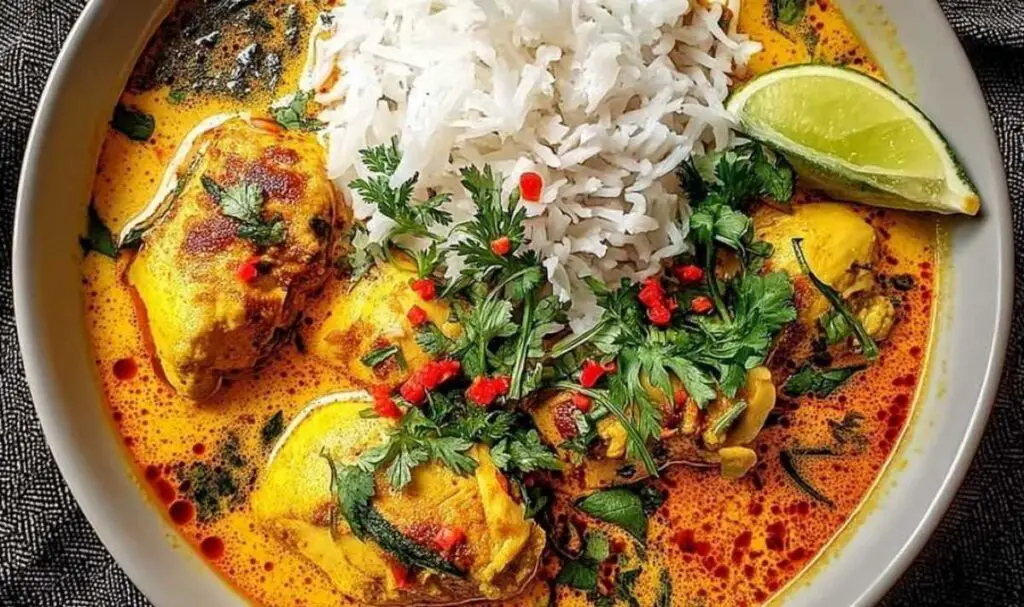
How to Make Coconut Chicken Curry
Creating this coconut chicken curry is all about building layers of flavor, and I’ve found the key is taking your time with each step to develop the deepest, most satisfying taste.
Step 1. I always start by heating the oil over medium heat and sauteing the onions until they’re translucent and fragrant – this usually takes about 5 minutes and creates the perfect flavor base.
Step 2. Betty’s tip is to add the garlic and ginger next, cooking just until fragrant (about a minute) – any longer and they might burn and turn bitter.
Step 3. Through years of making this, I’ve learned that toasting the spices for 30 seconds to a minute releases their essential oils and creates incredible depth – you’ll smell the difference immediately.
Step 4. I add the chicken pieces next, cooking just until they lose their pink color on the outside – they’ll finish cooking in the coconut sauce, so don’t worry about cooking them through at this stage.
Step 5. After testing different methods, I’ve found that stirring the tomato paste in with the coconut milk and broth prevents any lumps and creates the smoothest sauce.
Step 6. The secret I discovered is letting the curry simmer gently for 20-25 minutes – this allows the chicken to become fork-tender while the sauce reduces to the perfect consistency.
Step 7. My family prefers when I finish with fresh lime juice and cilantro right before serving – it brightens every spoonful and adds that restaurant-quality touch.
Storage and Reheating Tips
One of the best things about this coconut chicken curry is how wonderfully it keeps, making it perfect for meal prep and busy weeknights ahead.
I typically store leftovers in airtight containers in the refrigerator for up to 4 days, and honestly, the flavors continue to develop and improve during that time. Betty always made extra curry on purpose because she knew it would taste even better the next day. The spices have more time to meld together, creating an even richer, more complex flavor profile.
For freezing, this curry works beautifully and can be stored for up to 3 months. I recommend freezing in portion-sized containers so you can thaw exactly what you need. Betty’s freezing method works well because the coconut milk base maintains its creamy texture even after freezing, unlike some dairy-based sauces.
For the best texture when reheating, I reheat gently on the stovetop over medium-low heat, stirring occasionally and adding a splash of chicken broth if the sauce has thickened too much. The microwave works in a pinch, but stovetop reheating preserves that silky coconut texture much better.

Coconut Chicken Curry
Ingredients
Equipment
Method
- Heat the vegetable oil in a large pan over medium heat. Add the onions and sauté until they are translucent and soft, about 5 minutes.
- Stir in the ground cumin, ground coriander, turmeric, and cayenne pepper (if using). Cook the spices for about 30 seconds to a minute until they release their aroma.
- Add the chicken pieces to the pan. Cook until they are no longer pink on the outside, about 5-7 minutes.
- Pour in the coconut milk and chicken broth. Stir in the tomato paste and bring the mixture to a gentle simmer.
- Season with salt, pepper, and sugar. Adjust the seasoning according to your taste preference.
- Cover the pan and let the curry simmer gently for about 20-25 minutes, stirring occasionally, until the chicken is cooked through and tender.
- Once the chicken is cooked, stir in the lime juice and sprinkle the chopped cilantro over the curry.
- Serve hot over cooked rice or alongside warm naan bread.
Notes
Perfect Partners for Coconut Chicken Curry
This rich, aromatic coconut chicken curry pairs beautifully with sides that can soak up all that delicious sauce while providing textural contrast.
- Jasmine rice – The fluffy, slightly sticky texture is perfect for absorbing every drop of that creamy coconut sauce
- Warm naan bread – Great for scooping up the curry and adds a lovely chewy texture contrast
- Steamed basmati rice – The long grains stay separate and provide a neutral base that lets the curry flavors shine
- Simple cucumber salad – The cool, crisp freshness cuts through the richness beautifully
- Roasted vegetables – Try bell peppers or zucchini to add more nutrition and color to your plate
- Fresh cilantro and lime wedges – Essential garnishes that add brightness and allow everyone to customize their bowl
I love serving this curry family-style with several of these options so everyone can build their perfect plate according to their preferences.
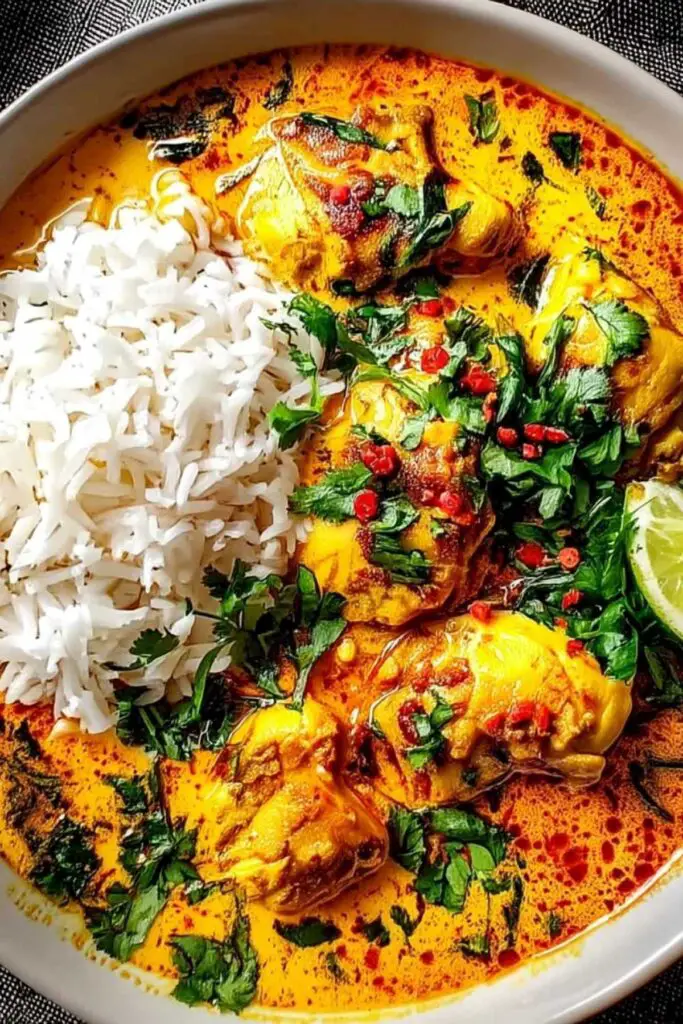
FAQs
- Can I use chicken breasts instead of thighs? I recommend sticking with thighs because they stay much more tender and juicy during the longer cooking time, but if you prefer breasts, reduce the cooking time to prevent them from drying out.
- How can I make this curry spicier? To increase the heat, I suggest adding more cayenne pepper or including some fresh jalapeños with the garlic and ginger – start with small amounts since you can always add more.
- Can this curry be made ahead of time? Many home cooks find that this curry actually improves when made a day ahead – the flavors have more time to develop and meld together beautifully.
- What’s the best way to prevent the coconut milk from separating? Betty’s solution is to keep the heat at a gentle simmer rather than a rolling boil, which helps maintain the creamy texture throughout cooking.
- Can I add vegetables to this curry? The best approach I’ve tested is adding heartier vegetables like bell peppers or carrots early in the cooking process, while leafy greens like spinach should be stirred in during the last few minutes.



